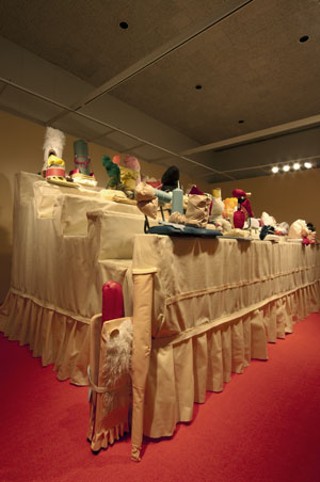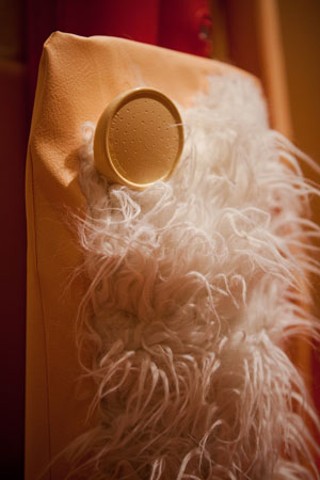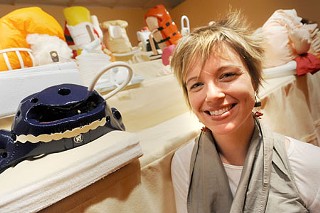In the Game
For her first museum work, Jade Walker steps up to the plate and swings big
By Robert Faires, Fri., Jan. 22, 2010
When you step into the space holding the large installation that Jade Walker has created for the Austin Museum of Art, there's no question where you are. The crunch of artificial turf under your feet, the bleachers filling the room: This is a stadium, and by virtue of the fact that you're looking up at the stands, you're on the field. In the game. Where the action is.
It's a place that the creator of this imposing, ambitious work should know something about. In Austin's visual arts scene, she's as deep in the action as it gets. Since making her way to Austin in 2002 to pursue graduate studies in sculpture at the University of Texas, Walker has taught art courses to children at AMOA's Art School. For six years, she's been teaching three-dimensional design to university students in the UT Department of Art & Art History. Since 2006, she's been the director of Creative Research Laboratory, the off-campus contemporary art gallery run by the department; 16 months ago, she was also named the curator for the gallery in the AT&T Executive Education and Conference Center at UT; and this year, she's taking on the position of director of the new Visual Arts Center in the art department. On top of all that, she's been extremely busy as an artist, with her signature sculptures of found objects, fabric, and thread showing up in the annual faculty exhibitions at CRL and People's Gallery exhibitions at City Hall, the juried "New American Talent" exhibition in 2008 and Texas Biennial in 2009, and the solo installation "Trophy Room" at Domy Books this past September. At the risk of belaboring the sports metaphor, that much activity qualifies Walker as a starter for the local team. Certainly, AMOA saw her that way when it tapped Walker to be the first person to exhibit in its "New Works" series, which spotlights innovative local artists.
"We knew we wanted an artist who would experiment and transform the gallery," says AMOA assistant curator Andrea Mellard, and "we thought of Jade. We'd been watching her work shift in scale from small wall installations to human-sized floor sculptures and ceiling installations. We thought that she was ready to try a room-sized installation in a museum. Her work is also engaging formally, visually, and conceptually. Austin is known for a strong craft community, and while Jade has an M.F.A. and doesn't consider her work craft, we thought her use of textiles, DIY practice, and stitch-work would be exciting to that audience. Mostly, we wanted to choose an artist taking a leap in a new direction, and we thought Jade was ready to accomplish that."
Mellard called on Walker at her studio to broach the subject of her possibly taking on a "New Works" project: "I posed the question, 'If you could do anything in that room, what would you do?' Often, emerging artists have parameters to work within, like making work that fits into an allotted space in a group show or that will sell in a commercial gallery. I want this to be a place for experiment and play."

That's just what Walker was primed to do: "I was very interested in working on a large installation. There were no real parameters on the exhibition, and this was what really excited me about the opportunity."
As Mellard notes, Walker had been in the process of expanding her work, in terms of both the size of the individual sculptures and the space in which they were presented, and AMOA's invitation would really allow her to get big with it. She wanted to make work of a size that would command the space, confront the audience. "This exhibition afforded me the chance to completely take over a large space and push my skill set in terms of handling scale," she says. "It was necessary to have the staff and installation crew to make this piece happen." For Walker, "New Works" was the artistic equivalent of – okay, one more sports metaphor – the minor leaguer with dreams of the majors getting called up to the show.
In the AMOA project, Walker chose to take advantage of the opportunity not only to play with scale but to dig more deeply into a subject that had become a focus of her work: sports. While her previous art had been rooted in the human body, specifically in how it is affected by disease, aging, and physical abnormalities, it didn't include the strain and trauma that can be inflicted through athletics, mostly because Walker had little personal knowledge of or experience with sports.
"It was not until I read an excerpt from Michael Sokolove's text Warrior Girls in The New York Times that I homed in and started thinking about the ailments to the body caused by the drive in athletics," she says. "I found this text particularly interesting because it addresses young women's athletics. Gender issues in the arts run parallel with women's athletics. This led to discussions with female athletes, as well as investigating spaces that contain or glorify this intense passion. I am attracted to the way female athletes push the limits of the body while also feeling that this is not necessary and wondering how this will affect our future feminist efforts."
Walker took a swing at the topic with "Trophy Room," her site-specific installation at Domy Books. She carpeted the floor of the 11-foot-by-11-foot room with green artificial turf and swathed the walls with sky-blue fabric that rippled and puckered over indistinguishable shapes, bulges, and small ledges. Perched on each ledge was a small piece of sports equipment – a football, a bowling pin, a golf club head – with pink and tan fabric sewed over it. The work managed to evoke in this tightly enclosed space a sense of the outdoors where these sporting activities take place, and the fabric suggested the flesh with which we touch and grasp and play with these objects, almost as if skin had grown over them from all that contact and someone had carefully, tenderly sealed these playthings inside it. Walker had created an immersive setting for the viewer in establishing a relationship between our bodies and athletics, but she thought that, in the words of Mellard, "there was more to flesh out of the subject for her AMOA piece."

As curator for Walker's "New Works" project, Mellard assisted her in the fleshing out. "I contacted a friend who is a sports historian, and he gave Jade and me a reading list – books on women's sports history, documentary photographs of stadiums and sporting events, et cetera, and contacts for a sports historian at UT. We talked about artists' work relating to sports that might inspire her, particularly a group show called 'Mixed Signals' about masculinity and sports. I was mostly a sounding board for Jade as the project developed. Once she had a pretty clear idea of what she wanted to do, I encouraged her, asked questions, and helped solve logistical problems. We had four more studio visits, when I'd come see the progress of the sculptures and give her feedback."
It was assistance that Walker found invaluable. "Andrea visited my studio a number of times. We corresponded often throughout the process. She also was very involved in helping with print pieces and solving mistakes that came up during the installation process. When they delivered green instead of orange turf while I was out of town for work, she found a way to get the mistake remedied within days. The encouragement from Andrea to think big and to make the piece exactly what I imagined – with no compromises – was also important. I told her this was the first 'large-scale' piece that came out to be exactly what was in my mind and in my sketches."
What came out of Walker's mind was a full-size section of bleachers, like you might find behind a backstop at Krieg Fields or a Little League ballpark, but completely covered in pale-beige fabric with a ruffled skirt around its base. Where the spectators sit are an assortment of different of seats and cushions, on which are set abstract sculptures made from sports equipment, colored fabric, plastics, and fur, some of them tied with ribbons or sewn with thread. Most don't look remotely human, yet we make the connection with them as such through the way these objects occupy the seats that we would at a sporting event and the recognizable fragments of items we use that poke through the enveloping, binding cloth: a barbell, a showerhead, the rubber tip of a crutch, a hot-water bottle, a boxing glove. Because some of them appear worn or used, they convey a sense of damage sustained on the field of play, the thread suggesting sutures to bind their wounds, the cloth their protective bandaging. Given that the artist has purposely placed us on the field – you can't take a step without being reminded of it by that skeevy scrunch of the bright-orange plastic turf – we're left to consider what it means to still be in the game (whatever game that is) and what injuries we might yet incur that would consign us to the stands beside these wounded "players." Walker's choices of certain fabrics and decorations and the protuberances of a distinctly sexual nature that she's added to some of the objects bring gender into the game and provoke questions about just who gets to play when it comes to sports, who's left to watch, and what that means. With Spectator Sport, the artist has succeeded in filling up the "New Works" exhibition space not just with the commanding physical structure but with ideas and questions that linger long after you've stepped away from the field. No wonder Walker is pleased.
She isn't alone. "I'm thrilled with Spectator Sport as our first 'New Works' project," says Mellard. "The room glows with color, the carpet crunches under footsteps. The overwhelming scale of the bleachers draped in fabric and seated with abstract figures confronts you like they are watching you on the field. Longer looking surprises you by revealing all the found materials Jade recycled, covered, painted, wrapped, and turned into art. Jade's installation works on several levels: Schoolchildren love playing 'eye spy,' M.F.A. art students appreciate her connections to feminist art history, UT athletics fans are surprised to find contemporary art about sports, and tourists have never seen anything like it. It's exactly the kind of cutting-edge new work I hoped to see in that space."
The public reception to the work pleases Walker, too: "The response to the work has felt superpositive. My favorite responses were from children the night of the opening and the preview night. Their interpretations are always innocent and honest, and I have found their delight in the work inspirational."
Inspirational. A quality that's common to narratives about sports – the athlete who trains, who perseveres, who triumphs, sometimes against injury, personal tragedy, seemingly insurmountable odds – and Walker's work with the subject seems to be informing what she hopes to do as an artist, a teacher, and a curator. "In thinking about my aspirations not only as a part of the Austin arts community but specifically in each of my roles, I keep thinking of a word that is so overused: inspire," she says. "I want to arouse viewers with my work as an artist. I want students to think about new ideas as we engage in conversation, and I want to challenge the community as I program the Visual Arts Center. The Visual Arts Center will be an instigator – a place for process and risk. Qualities applicable to the Visual Arts Center may include being immediate, flexible, vital, welcoming, all-encompassing, experimental, educational, open, evolving, collaborative, collective, explosive, and challenging."
Sounds like Jade Walker plans to be in the game for a long time to come.
"New Works: Jade Walker" runs through Jan. 31 at the Austin Museum of Art – Downtown, 823 Congress. Jade Walker talks about the inspiration and process for making her installation Spectator Sport Thursday, Jan. 21, 7pm, at AMOA. For more information, call 495-9224 or visit www.amoa.org.









